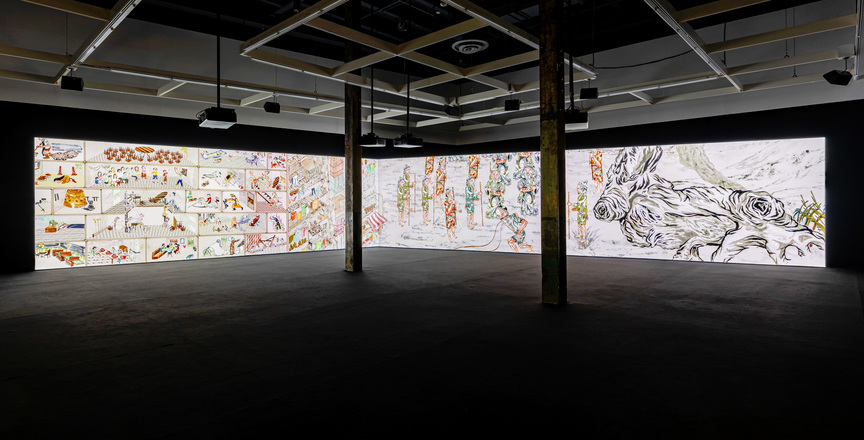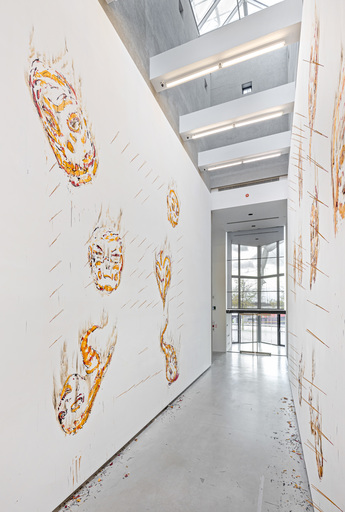-
From Current Issue
-
- Editor’s Letter Fire in the Heart
- Reviews I Gusti Ayu Kadek Murniasih
- Reviews 11th Seoul Mediacity Biennale: “One Escape at a Time”
- Dispatch Networked China
- One on One Monira Al Qadiri on Yukio Mishima
- Essays The rise of independent art spaces in pandemic-era Shanghai
- Features Tuan Andrew Nguyen
- Table of Contents
- Web Exclusives
- Archive
- Subscribe

R
E
V N
E
X
T
Installation view of HOWIE TSUI’s Retainers of Anarchy, 2017, five-channel algorithmic animation sequence, six-channel audio: 3.4 × 24.2 m, at “From swelling shadows, we draw our bows,” The Power Plant, Toronto, 2020. Photo by Toni Hafkenscheid. Courtesy the artist.
Howie Tsui’s “From swelling shadows, we draw our bows” detoured the art-historical lineage of Zhang Zeduan’s renowned Song Dynasty scroll painting: Along the River During the Qingming Festival (清明上河圖c. 1100). Loaned for prominent international exhibitions as a tool of cultural diplomacy, Zhang’s masterpiece depicts lively festivities in the Northern Song capital of Bianjing. Its government-sponsored reinvention as an immersive digital installation, River of Wisdom (2010), attracted much fanfare at Shanghai’s Expo 2010, the same year pro-democracy protests exploded in Hong Kong—a bout of political unrest that complicated the work’s official positioning as a symbol of national pride and unity.
Tsui’s exhibition at The Power Plant departed from River of Wisdom to problematize utopic celebrations of statehood and unnuanced spectacle. Retainers of Anarchy (2017), an anachronistic adaptation of the Song Dynasty tableau, formed the exhibition’s backbone. This panoramic audiovisual animation, generated live by an algorithm, takes Kowloon Walled City (1898–1994) as its primary site. Frequently used as a territorial bargaining chip, the landmark underwent changeovers and takeovers that secured its notoriety for squatting, organized crime, and government negligence. Nonetheless, its occupants proved a thriving social ecology—an untold history highlighted by Anarchy.
Leveraging popular culture for a subversive but approachable sensibility, Tsui foregrounded themes of state violence, censorship, and vigilante resistance with twentieth-century wuxia (martial heroes) motifs. Wuxia, a narrative genre, spotlights proletarian heroes who gain supernatural abilities through Taoist cultivation and fight against authoritarian power with wushu (martial arts). Once censored in China, wuxia’s revolutionary storylines achieved global prominence via Hong Kong television, film, and comics. In Anarchy, Tsui rides this popular momentum to highlight the agency and self-actualization of the socially disadvantaged.
An open cross-section of Tsui’s walled city reveals tenement apartments stacked like cartoon panels. The tenants, in clothes that span Song Dynasty tradition to early ’90s fashion, straddle historical and contemporary worlds. Elevation and shapeshifting insert martial arts fantasy into the everyday bustle of meat shops, dentist offices, and classrooms. One vignette reprises the famous scene in the wuxia classic Legends of Condor (1957) in which protagonist Yang Guo loses his arm by sword, albeit relocated to an apartment unit with Hong Kong-style floor tiling and metal door grill.
Though heavy-handed celebrations of resilience can reproduce false utopias, Tsui tempered triumph-over-adversity narratives with images of punishment, death, and ennui. Outside of the walled city and closer to the margins of the panorama, pro-democracy activist Joshua Wong appears in a cage, straining to reach a plate of fish. Diving further into political anguish, Parallax Chambers (2018– ), a single-channel animation, made prison-like torture chambers of common Hong Kong spaces, such as small apartments with Buddhist family altars and burning paper dumplings, and a 1960s-style Chinese restaurant with dated wooden booths and round tables. One scene features sobbing cangue-wearers impaled on stakes among waste-paper stacks, referencing the economic and environmental implications of the 2017 “paper jam crisis,” in which China’s decision to halt “foreign” waste imports from Hong Kong piled trash in the streets and triggered sharp decreases in cardboard collector wages. Meanwhile, nearby lightboxes evoking film posters showcase scenes from Parallax Chambers. Crossbreeding movie memorabilia with museum display substrates, Tsui stresses mass media’s capacity to carry dissident narratives across spatio-temporal boundaries.
In the Fleck Clerestory, A Geomantic Corridor (2020) stood out from other works. Fragrant joss sticks punctured this site-specific fresco like map pins. A bagua mirror (an octagonal talisman that reflects bad energy in feng shui) hung above the Clerestory’s entrance. Loose gestural contours conjured ghostly figures onto the walls. Altogether, these seemed to trace a hauntological map of qi flows, alluding to the reincarnation of historical phantoms. An extension of the Spectral Residue series, Tsui has described this body of work as a “process-based interpretation[s] of the supernatural through automatic drawings, impression-making, and a smoke-staining technique.”
Activating paper and ink, screen and filmic projection, algorithm and pixels, Tsui’s exhibition disrupted canonical Chinese art history. Galvanized by popular culture and magic realism, it encouraged generative social imaginaries and offered multiple vantage points for reflection. This parallactic drift simultaneously dizzied and reinvigorated, epitomizing the contentious and unpredictable nature of bearing political witness through art.
Howie Tsui’s “From swelling shadows, we draw our bows” was on view at The Power Plant Contemporary Art Gallery, Toronto, from September 26, 2020, to January 3, 2021.
To read more of ArtAsiaPacific’s articles, visit our Digital Library.


















